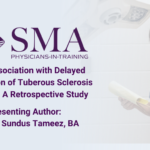Abstract | May 4, 2021
Race Association with Delayed Recognition of Tuberous Sclerosis Complex: A Retrospective Study
Learning Objectives
- Be aware that the dermatologic manifestations of TSC, which are often a key feature in diagnosis, appear differently across the races;
- Notice the differences in dermatological features include the presentation of angiofibromas. In Black patients, facial angiofibromas may be confused for seborrheic keratoses or other benign epidermal growths;
- Recognize these differences within Black patients might delay the timing of diagnosis or lead to a misdiagnosis.
Background:
Tuberous sclerosis complex (TSC) is a genetic disorder that results in the growth of hamartomas in various organs. It is caused by an autosomal dominant or spontaneous mutation in TSC1 or TSC2 genes. Diagnosis is based on the presence of a specific combination of major and minor features. The objective of this report is to determine if the diagnostic timing of TSC may be impacted by race due to differences in skin lesion appearance.
Methods:
We conducted a retrospective chart review of patients with TSC evaluated in our TSC clinic as of 2015. Chi-squared tests for independence between race and age at diagnosis and features identified were conducted. Multivariable logistic regression was used to investigate the effect of race on the timing of diagnosis, adjusting for sex and the number of major features.
Results:
Forty-one individuals were included in the analysis. Black patients were more commonly diagnosed at later ages with 50% (9/18) diagnosed before age 1 year, compared with 70% (16/23) of non-Black patients (White/other). Black patients had decreased odds of diagnosis by age 1 year, but this association was not statistically significant (odds ratio [OR], 0.27; P = 0.091). Having ≥5 major features led to significantly higher odds of being diagnosed earlier compared with having one to four features (OR, 0.14; P = 0.02).
Conclusion:
Differences in diagnostic timing of TSC between races warrant further study in larger multisite populations, as this study identified a trend toward a later diagnosis in Black patients compared with White patients.

